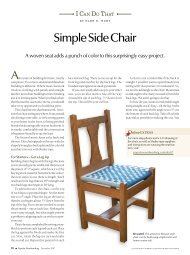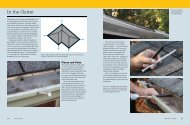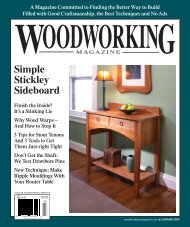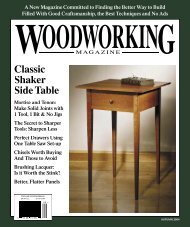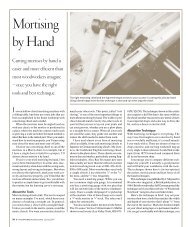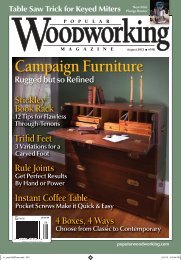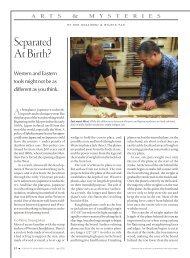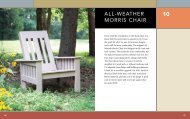Classic Shaker Side Table - Popular Woodworking Magazine
Classic Shaker Side Table - Popular Woodworking Magazine
Classic Shaker Side Table - Popular Woodworking Magazine
Create successful ePaper yourself
Turn your PDF publications into a flip-book with our unique Google optimized e-Paper software.
WOODWORKINGM AG A Z I N EAutumn 2004woodworking-magazine.comEditorial Offices 513-531-2690EDITOR & PUBLISHER ■ Steve Shanesyext. 1238, steve.shanesy@fwpubs.comART DIRECTOR ■ Linda Wattsext. 1396, linda.watts@fwpubs.comEXECUTIVE EDITOR ■ Christopher Schwarzext. 1407, chris.schwarz@fwpubs.comSENIOR EDITOR ■ David Thielext. 1255, david.thiel@fwpubs.comMANAGING EDITOR ■ Kara Gebhartext. 1348, kara.gebhart@fwpubs.comASSOCIATE EDITOR ■ Michael A. Rabkinext. 1327, michael.rabkin@fwpubs.comILLUSTRATOR ■ Matt BantlyPHOTOGRAPHER ■ Al ParrishCIRCULATIONGroup Circulation Manager ■ Mark FleetwoodPRODUCTIONVice President ■ Barbara SchmitzPublication Production Manager ■ Vicki WhitfordProduction Coordinator ■ Brian CourterF+W PUBLICATIONS, INC.William F. Reilly ■ ChairmanStephen J. Kent ■ PresidentMark F. Arnett ■ Executive Vice President & CFOF+W PUBLICATIONS, INC. MAGAZINE DIVISIONDavid Hoguet ■ Group HeadColleen Cannon ■ Senior Vice PresidentNewsstand Distribution: Curtis Circulation Co.,730 River Road, New Milford, NJ 07646You can order our first issue for $7 ($9 Canada; $11 other foreign).This includes shipping and handling. Send check or money orderto: <strong>Woodworking</strong> <strong>Magazine</strong> Spring 2004 Issue, F+W PublicationsProducts, 700 E. State St., Iola, WI 54990, or call 800-258-0929.Please specify <strong>Woodworking</strong> <strong>Magazine</strong>, Spring 2004 issue.IMPORTANT SAFETY NOTESafety is your responsibility. Manufacturers place safetydevices on their equipment for a reason. In many photos yousee in <strong>Woodworking</strong> <strong>Magazine</strong>, these have been removed toprovide clarity. In some cases we’ll use an awkward bodyposition so you can better see what’s being demonstrated.Don’t copy us. Think about each procedure you’re going toperform beforehand. Safety First!Highly RecommendedThough some people prefer new tools,there is great merit in purchasing vintagechisels – if you know what to buy. Premiumsocket chisels are still widely available atflea markets and through eBay, and cancost from $2 to $25 apiece. With some exceptions,these chisels are better than newones. The steel holds a better edge, thehandles fit your hand better and the bevelson the sides are ground much smallerso you can easily sneak into corners.We’ve had immense success with the lowing vintage (and now-vanished) models:fol-Witherby, Swan (shown), E.A. Berg and oldBuck Brothers socket chisels.Avoid buying rusty ones, especially ifthere is pitting on the face of the tool. Thehandles should feel good when paring andchopping. Most of all, look for chisels thatwere used as a chisel – not as a pry bar. Beatupchisels are difficult to restore.– Christopher SchwarzOn the LevelThe Process is the PrizeIf I asked you what made a piece of music soundgreat, chances are you’d respond by saying it’s thenotes. But that’s only partially correct. The spaces,or time between the notes, are equally (somewould even say more) important. The same successionof notes played with more or less timebetween them would produce a totally differentsong. Odds are, it would sound awful.So what does this have to do with woodworking?Glad you asked.Let me apply the music question to the craft ofwoodworking. What makes woodworking so enjoyable?There must be something to this activity,because at least a million people in the UnitedStates and Canada say they are woodworkers.If you asked them, I bettheir responses wouldbe something like: “Ienjoy making things,using my hands.” Onceagain, I believe this isonly partially correct.The mere act ofmaking things may notbe all that enjoyable.But combine that act (the musical notes) withall the thinking required to perform the act correctly(the spaces of time between the notes) andyou have the essence of what makes woodworkingso enjoyable.Let me elaborate. The actual doing – say, thecutting of a board or the gluing of parts – if donerepetitiously for hours on end wouldn’t be enjoyableat all. Have you ever made 20 or 30 of thesame thing? It can get old very fast. It’s the brainworkthat puts the joy in woodworking.Consider all the thinking required, the problemsto be solved and decisions to be made, oneven the simplest project. What joint should Iuse? Is that joint the best choice? How do I makethe joint? Is that the best way to make it? Hundredsof choices must be sifted through, considered,decided on and executed in even simpleprojects. Larger projects require thousands ofthought processes before your efforts come to asuccessful conclusion.A major reason novice woodworkers experiencetremendous frustration is not so muchfrom a lack of skill. It really isn’t hard to cut aboard to a specified size, to rout an edge profileor glue a couple of parts together. In fact, when“It’s good to have an end to journeytoward; but it is the journeythat matters, in the end.”— Ursula K. Le Guin (1929 – )novelist, poet, essayistyou break down the physical skills required tobuild a project into individual steps, they’re oftenrather simple. Instead, the frustration the novicefeels comes from the lack of experience in makinggood decisions about how to go about completinga task successfully. The frustrations andresulting insecurity lead to a lack of confidencethat comes from navigating unfamiliar territory.A series of less-than-good choices makes fora bad day in the shop.That’s partially why beginners rush to completeprojects. They focus on the end project, notthe process. For these reasons, the beginner’s finishedproject often looks amateurish. Noviceslack the ability to understand the importanceof the means to achievea desirable end. They“don’t know enough toknow they don’t know,”as the expression goes.That’s why many peoplethink patience is thehardest thing to learnabout woodworking.Alternately, considerthe confident, experienced woodworker. Hecalls on experience to direct the work as he movesseamlessly through each task. He makes the rightchoices, anticipates problems, knows how andwhen to go slow, be patient and get it just rightbecause he knows not doing so will create otherproblems down the road. The experienced woodworkerfocuses on the process of doing the work.As he works through each step, he spends littletime thinking about the completed project.For the experienced woodworker and thoseon their way to becoming one, the day of enlightenmentcomes with two realizations: First,that you just spent hours in the shop and it seemslike minutes. And second, you feel relaxed, evenrefreshed, after hours of hard labor. The joy ofwoodworking is simply being engaged in doingit. The completed project is but a nice souvenirof time well spent. WMSteve ShanesyEditor & Publisherwoodworking-magazine.com ■ 1



